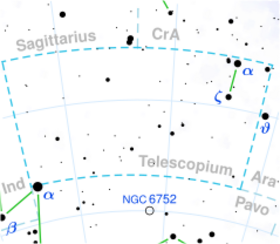Astronomy:Iota Telescopii
| Observation data Epoch J2000.0 Equinox (celestial coordinates) | |
|---|---|
| Constellation | Telescopium |
| Right ascension | 19h 35m 12.98634s[1] |
| Declination | −48° 05′ 57.1238″[1] |
| Apparent magnitude (V) | 4.88±0.01[2] |
| Characteristics | |
| Spectral type | K0 III[3] |
| B−V color index | +1.09[4] |
| Astrometry | |
| Radial velocity (Rv) | +22.3±0.8[5] km/s |
| Proper motion (μ) | RA: −8.190[1] mas/yr Dec.: −36.977[1] mas/yr |
| Parallax (π) | 8.6546 ± 0.1055[1] mas |
| Distance | 377 ± 5 ly (116 ± 1 pc) |
| Absolute magnitude (MV) | −0.39[6] |
| Details | |
| Mass | 2.53±0.19[7] M☉ |
| Radius | 19.7±1.0[8] R☉ |
| Luminosity | 172+5−4[1] L☉ |
| Surface gravity (log g) | 1.88[9] cgs |
| Temperature | 4,738±55[7] K |
| Metallicity [Fe/H] | +0.01±0.04[7] dex |
| Rotational velocity (v sin i) | 1.8±1.3[10] km/s |
| Other designations | |
| Database references | |
| SIMBAD | data |
ι Telescopii, Latinized as Iota Telescopii and abbreviated Iota Tel, is a solitary star[12] located in the southern constellation Telescopium. It is faintly visible to the naked eye as an orange-hued star with an apparent visual magnitude of +4.88.[2] The star is located roughly 377 light years distant from the Solar System based on Gaia DR3 parallax measurements[1] and it is receding with a radial velocity of 22.3 km/s.[5] At its current distance, Iota Tel's brightness is diminished by 0.19 magnitudes[13] due to interstellar dust and it has an absolute magnitude of −0.39.[6]
This object is an aging red giant star with a stellar classification of K0 III.[3] At present it has 2.53 times the mass of the Sun,[7] but it has expanded to 19.7 times the radius of the Sun.[8] It is radiating 172 times the Sun's luminosity[1] from its swollen photosphere at an effective temperature of 4,738 K.[7] Iota Tel has a near solar metallicity at [Fe/H] = +0.01[7] and it spins slowly with a projected rotational velocity of 1.8 km/s.[10]
References
- ↑ 1.0 1.1 1.2 1.3 1.4 1.5 1.6 Vallenari, A. et al. (2022). "Gaia Data Release 3. Summary of the content and survey properties". Astronomy & Astrophysics. doi:10.1051/0004-6361/202243940 Gaia DR3 record for this source at VizieR.
- ↑ 2.0 2.1 Høg, E.; Fabricius, C.; Makarov, V. V.; Urban, S.; Corbin, T.; Wycoff, G.; Bastian, U.; Schwekendiek, P. et al. (March 2000). "The Tycho-2 catalogue of the 2.5 million brightest stars". Astronomy and Astrophysics 355: L27–L30. ISSN 0004-6361. Bibcode: 2000A&A...355L..27H.
- ↑ 3.0 3.1 Houk, Nancy (1978). Michigan catalogue of two-dimensional spectral types for the HD stars: Declinations −53° to −40°. 2. Bibcode: 1978mcts.book.....H.
- ↑ Cousins, A. W. J. et al. (1966), "Photoelectric magnitudes and colours of southern stars, II", Royal Observatory Bulletins 121: 1, Bibcode: 1966RGOB..121....1C.
- ↑ 5.0 5.1 Gontcharov, G. A. (November 2006). "Pulkovo Compilation of Radial Velocities for 35,495 Hipparcos stars in a common system". Astronomy Letters 32 (11): 759–771. doi:10.1134/S1063773706110065. ISSN 1063-7737. Bibcode: 2006AstL...32..759G.
- ↑ 6.0 6.1 Anderson, E.; Francis, Ch. (May 2012). "XHIP: An extended hipparcos compilation". Astronomy Letters 38 (5): 331–346. doi:10.1134/S1063773712050015. ISSN 1063-7737. Bibcode: 2012AstL...38..331A.
- ↑ 7.0 7.1 7.2 7.3 7.4 7.5 Ottoni, G.; Udry, S.; Ségransan, D.; Buldgen, G.; Lovis, C.; Eggenberger, P.; Pezzotti, C.; Adibekyan, V. et al. (January 2022). "CORALIE radial-velocity search for companions around evolved stars (CASCADES): I. Sample definition and first results: Three new planets orbiting giant stars". Astronomy & Astrophysics 657: A87. doi:10.1051/0004-6361/202040078. ISSN 0004-6361. Bibcode: 2022A&A...657A..87O.
- ↑ 8.0 8.1 Kervella, P.; Thévenin, F.; Di Folco, E.; Ségransan, D. (October 2004). "The angular sizes of dwarf stars and subgiants. Surface brightness relations calibrated by interferometry". Astronomy & Astrophysics 426 (1): 297–307. doi:10.1051/0004-6361:20035930. ISSN 0004-6361. Bibcode: 2004A&A...426..297K.
- ↑ McDonald, I.; Zijlstra, A. A.; Watson, R. A. (15 June 2017). "Fundamental parameters and infrared excesses of Tycho–Gaia stars". Monthly Notices of the Royal Astronomical Society 471 (1): 770–791. doi:10.1093/mnras/stx1433. ISSN 0035-8711. Bibcode: 2017MNRAS.471..770M.
- ↑ 10.0 10.1 De Medeiros, J. R.; Alves, S.; Udry, S.; Andersen, J.; Nordström, B.; Mayor, M. (January 2014). "A catalog of rotational and radial velocities for evolved stars V: Southern stars *". Astronomy & Astrophysics 561: A126. doi:10.1051/0004-6361/201220762. ISSN 0004-6361. Bibcode: 2014A&A...561A.126D.
- ↑ "iot Tel". SIMBAD. Centre de données astronomiques de Strasbourg. http://simbad.u-strasbg.fr/simbad/sim-basic?Ident=iot+Tel.
- ↑ Eggleton, P. P.; Tokovinin, A. A. (11 September 2008). "A catalogue of multiplicity among bright stellar systems". Monthly Notices of the Royal Astronomical Society 389 (2): 869–879. doi:10.1111/j.1365-2966.2008.13596.x. ISSN 0035-8711. Bibcode: 2008MNRAS.389..869E.
- ↑ Gontcharov, George A.; Mosenkov, Aleksandr V. (28 September 2017). "Verifying reddening and extinction for Gaia DR1 TGAS main sequence stars". Monthly Notices of the Royal Astronomical Society 472 (4): 3805–3820. doi:10.1093/mnras/stx2219. ISSN 0035-8711. Bibcode: 2017MNRAS.472.3805G.
<ref> tag with name "Gould1879" defined in <references> is not used in prior text.
 |


